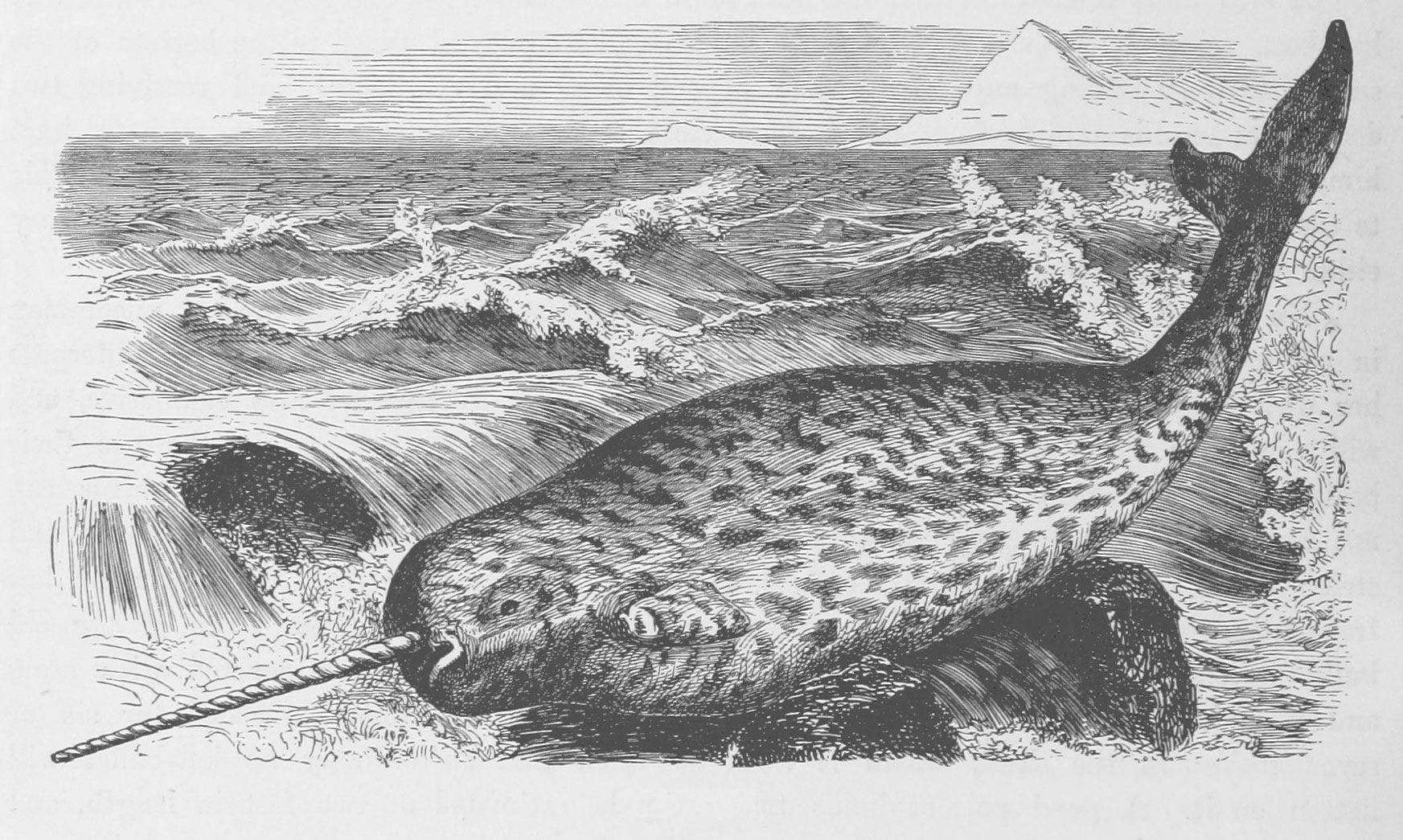Narwhal FAQ
What do narwhals eat? How deep do they dive? What is that tusk for? Take a dive below to learn about these fascinating animals.
The narwhal is one of the deepest diving whales, with the deepest dive recorded to date being 1,776 meters (5,827 feet, or over one mile below the surface).
The narwhal is an odontocete or toothed whale, but unlike all other toothed whales it has no teeth in its mouth. Instead, the male develops a long straight tooth (or tusk) that protrudes 2-3 m out of the upper left jaw. The tooth grows in a counterclockwise spiral. The tusk is unique to male narwhals. Very rarely, a female will grow a tusk, or a narwhal will grow two tusks. Tusks exported from the Arctic, perhaps by the Vikings, reached Europe, the Mediterranean, and even the Far East as early as the Middle Ages and became the source of the unicorn myth. The tusks were sold without a good description of the animal from which they came and inspired a great deal of fantasy.
To some extent, the tusks still inspire fantasies, as many explanations have been proposed for the purpose of the tusk, including: breaking ice, swordfighting, spearing fish for food, or for digging in the bottom the sea. In fact, none of these behaviors have ever been observed. One thing that is clear, is that the tusk can not serve a critical function for narwhals’ survival because females, who do not have tusks, still manage to live longer than males and occur in the same areas while additionally being responsible for reproduction and calf rearing.
The scientific consensus is that the narwhal tusk is a sexual trait, much like the antlers of a stag, the mane of a lion or the feathers of a peacock. Males use the tusk to determine social rank and compete for females. During the summertime in the northern Canadian high Arctic bays and fjords (long narrow inlets), male narwhals can be seen carefully crossing their tusks and making a strange, sad whistle. There is often a female between them. Such behavior might help maintain dominance hierarchies or help young males develop skills necessary for performance in adult sexual roles.

The sexual selection theory was originally proposed by Charles Darwin in his theories of sexual selection in his book The Descent of Man, and Selection in Relation to Sex (1871). Darwin makes the case very succinctly:
“When the males are provided with weapons which the females do not possess, there can hardly be a doubt that they … have been acquired through sexual selection.”

This observation echoes one made by the arctic explorer William Scoresby in his book: An Account of the Arctic Regions with a History and Description of the Northern Whale-Fishery (1820). Because his observations stand up to modern scientific scrutiny, I’d like to offer the following complete quote:
“The use of the tusk in narwals (sic.) is ambiguous. It cannot be essential for procuring their food, or none of them would be without it: nor is it, perhaps, necessary for their defence, else the females and young would be subjected to the power of enemies without the means of resistance, while the male would be in possession of an admirable weapon for its protection. Dr Barclay, with whom I have communicated on this subject, is of opinion, that the tusk is principally, if not solely, a sexual distinction, similar to what occurs among some other animals. Though it cannot be essential to the existence of the animal, it may, however, be occasionally employed.”
The deepest narwhal dives occur during winter, when the narwhals are in the offshore wintering grounds and in areas covered with sea ice.
Narwhals have a black and white mottled skin pattern on the dorsal size and are white underneath on their belly. Narwhals are born gray and as they age they turn black and white. Very old narwhals can be very white with few black spots. They are shaped similarity to beluga or white whale but are slightly more streamlined with less excess blubber and fat folds. The narwhal’s neck is not as flexible as a beluga. Male narwhals can reach a length of 5 meters (16 feet) and weigh up to 1,800 kg (4000 lbs). Females are slightly smaller, reaching a length of 4 meters (13 feet) and 1,000 kg (2200 lbs).
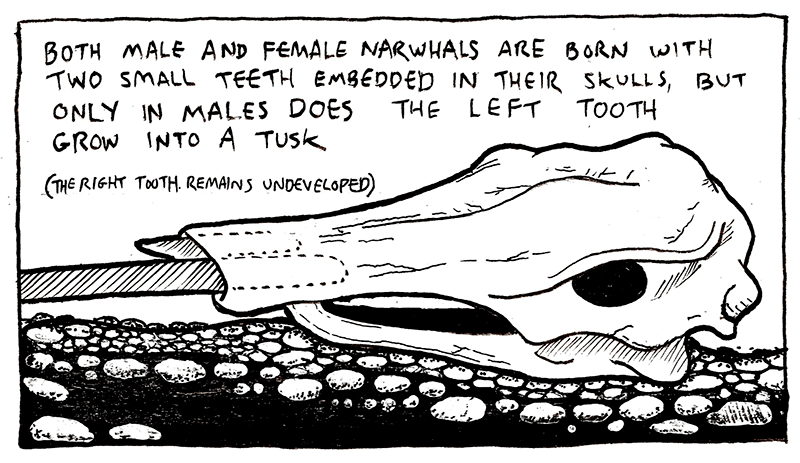
The scientific name for narwhal, Monodon monoceros, is derived from the Greek “one tooth, one horn”. The black and white skin coloration contributed to their common name “narwhal”. The old Norse prefix “Nar” means “corpse” and “hval” means “whale”. Thus “corpse whale” refers to how their skin color resembles that of a drowned sailor.
Narwhals reach sexual maturity between 6-9 years, and females give birth to a calf every third year, on average. The breeding period is in early spring (March-April) in the dense ice of their wintering grounds. The gestation period is about 14 months and they give birth in late spring (May-June) during their northbound migration to their summering grounds.
In summer, narwhals dive to depths between 30 and 300 meters, although they spend about a third of their time near the surface between 0 and 50 meters.
Recent research using aspartic acid racemization from the lens of the eye suggests narwhals can live to be 90 years old.

There are about 80,000 narwhals worldwide. They are distributed in the Canadian High Arctic, West and East Greenland and occasionally as far east as Svalbard. Narwhals exist in a number of smaller sub-populations or stocks. These are generally defined by where narwhals spend the summer, called the summering grounds. There are at least 10 sub-populations which have been identified by satellite tracking, genetics, and contaminant levels. Some of the biggest are on Somerset Island and Baffin Island, Canada and in Northwest Greenland. These summering populations range in size from a few thousand animals to 40,000 animals. There are also fall and winter aggregations of narwhals that have not yet been assigned to a summering ground. The degree to which narwhal sub-populations mix remains to be clearly determined but there is some overlap both in winter and summer ranges of a few sub-populations.
Narwhals can travel in small pods that can be 2-3 animals as well as pods that are several hundreds of whales. Pod sizes range widely and can consist of both males and females, or all-female or all-male pods.
Narwhals can dive more than a mile under the sea when the surface is covered in more than 99% sea ice.
Satellite tags are used to track the movements and behavior of narwhals. Tags mounted on a whale transmit signals at frequent intervals which are picked up by polar orbiting satellites high above the earth. When several signals have been received by one satellite, the position of the animal can be determined. Many positions are received from a whale each day but not all are adequately accurate. Satellite tags not only show where whales go but also what they did underwater. Information on diving, such as time beneath the surface, temperature, or light levels is transmitted in the form of coded numbers that are converted into data on dive activity and ocean features. Although it is only possible to instrument a few whales in a population with satellite transmitters, the method provides a straightforward method of recording where whales go every day. This method allows for the study of the movements, habitat use and behavior of narwhals for up to 14 months. We have learned a great deal about narwhals using satellite tracking technology. For example, until some whales were tracked, nothing was known about where specific narwhal populations spent the winter or the migratory routes along the coast of Greenland and Canada.
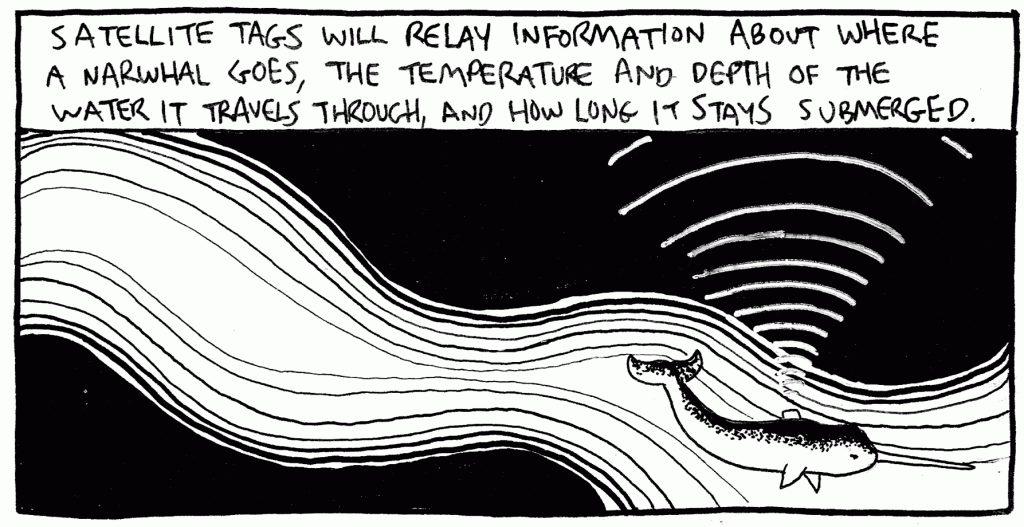
A one-mile narwhal dive is the same as swimming to the bottom of the deep-end of a pool 400 times without taking a breath.
Narwhals have predictable migration patterns and are creatures of habit. Even though they spend a large amount of time offshore far from humans, they still move along the coast, and pass certain promontories, bays or fjords at precisely the same time each year.
Narwhals partition their annual cycle between coastal ice-free summering grounds and offshore wintering grounds covered in dense pack ice. During the autumn, the narwhal’s summering grounds become covered in “fast ice”, i.e. ice that is connected to land and has no leads or cracks. Thus, narwhals leave coastal areas and migrate offshore before the fast ice forms. This migration, occurring between late September and mid-November, terminated when they reach their wintering grounds, which are offshore over deep waters and south of the summering grounds. In spring, narwhals migrate north back to their summering grounds. Narwhals choose similar wintering grounds year after year independent of sea ice conditions.
When narwhals return to the surface from deep dives they have to look for a breathing hole (a crack in the sea ice) using sound.
The narwhal is one of the deepest diving whales, with a record dive depth of approximately 1,800 m (5905 ft, over one mile). The deepest dives occur in winter, when the narwhals are in the offshore deep water wintering grounds. In summer, narwhals dive to depths between 30 and 300 meters, although they spend most of their time between 0 and 50 meters. In fall, dive depths and durations increase when narwhals migrate towards their wintering grounds. However, they are traveling rapidly during this period and do not do much focused diving. When narwhals are on their wintering grounds, they stay in a fairly limited area for 6 months and make small movements with the shifting leads and cracks in the pack ice. The proportion of shallow dives dramatically declines, and thus begins some of the deepest diving ever recorded for a marine mammal. Narwhals typically dive to at least 800 meters between 18 and 25 times per day every day for 6 months. Many of these dives go even deeper than 800 meters: over half reach at least 1,500 meters (4,500 feet). Dives to these depths last around 25 minutes, including the time spent at the bottom and the transit down and back from the surface. In addition to making remarkably deep dives, narwhals also spend a large amount of their time below 800 meters (>3 hours per day). This is an incredible amount of time at a depth where the pressure can exceed 2200 PSI (150 atmospheres) and life exists in complete darkness.
Narwhals travel to depths where there is intense pressure and no oxygen, which requires special adaptations for survival. The pressure problem is in part solved by having a compressible rib cage which is flexible and can be squeezed as the water depth increases. Narwhals also need mechanisms for bringing along as much oxygen as they can from the surface. They have a few solutions. Narwhals have a high concentration of myoglobin in their muscles (a molecule which binds oxygen): twice as much as some seal species and eight times as much as terrestrial mammals, even those specialized in fast running. An average-size narwhal can carry 70 L of oxygen in its lungs, blood, and muscles. This meets oxygen demands for more than 20 minutes underwater at swim speeds of 1 m/s. Furthermore, the narwhal does not have fast-twitch fibers in its skeletal muscles (like a dolphin) but instead has muscles that are suited for endurance swimming and are less oxygen demanding. During its dive, a narwhal can save oxygen by shutting off blood flow to selected organs or non-critical body parts. Finally, narwhals have streamlined bodies and can glide easily through the water column towards the bottom. This helps minimize oxygen consumption to work the muscles and ultimately saves energy.
Narwhals make deep dives to feed on the bottom of Baffin Bay and Davis Strait. Narwhals change their diet seasonally. In winter, they feed intensively on Greenland halibut or Gonatus squid. Greenland halibut are flatfish found on the bottom of the sea. The summer ice-free season (between July and September) is not used for intense feeding and whales have very little in their stomachs.
Narwhals can make daily dives to more than 800 meters as many as 25 times per day for 6 months.
Identifying what narwhals eat has proven to be a difficult task. Narwhals prefer waters far offshore covered in sea ice where they eat at great depths in complete darkness. Because of this, no direct observations of narwhal feeding have ever been made. An alternate method is to examine prey items in the stomachs of dead whales. Narwhals are harvested by local people throughout much of their range and in all seasons, therefore it is possible to collect the entire stomach (sometimes over 35 kg) from narwhals, freeze them, and send them to a laboratory for examination.
Hundreds of narwhal stomachs have been examined in the laboratory and several interesting patterns have been identified. Narwhals eat only a few prey species. Their primary prey are Greenland halibut; however, they also feed on polar and Arctic cod, shrimp and Gonatus squid. Occasional exceptions have included wolffish, capelin, skate eggs and sometimes rocks, accidentally ingested when whales feed near the bottom. Very few other prey items have been found in narwhal stomachs, implying that narwhals have a very restricted and specialized diet. The size of narwhal prey vary. Greenland halibut eaten by narwhals range from 35-55 cm in length and weigh between 200-1400 grams. Squid eaten by narwhals are much smaller and weigh on average 23 grams.
Narwhals are the only whale that winters in the dense Arctic pack ice. There is often less than 3% open water on the wintering grounds (1 February and 15 April) and minimum estimates are 0.5%, corresponding to only 150 to 400 km2 of open water available for breathing in a 25,000 km2 large area. These opening are long, thin fissures called “leads” which are caused by currents and wind pushing the ice sheets around. They are not permanent features and constantly appearing and disappearing and moving around. The reason narwhals return year after year to an area with such dense sea ice cover is unclear. Although some believe these whales are seeking refuge from killer whales, it is more likely that narwhals need access to predictable prey. Narwhal survival on the northbound spring migration and female condition during calving and nursing in late spring/early summer may depend on food intake during the winter. Therefore the reliable Greenland halibut resources of Baffin Bay provide an attractive food source for surviving the harsh arctic winter.
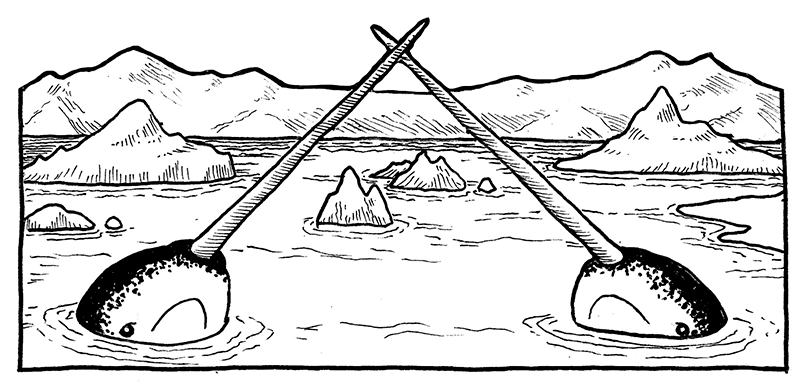
Although narwhals spend much of their time in heavy ice, they are vulnerable to unique events called ice entrapments or ‘sassats’. During an ice entrapment, hundreds of whales might become trapped in a small opening in the sea ice and they often die. This occurs when sudden changes in weather conditions (such as shifts in wind or quick drops in temperature) freeze the open water and the leads and cracks are sealed shut. Narwhals occupy dense pack ice for half of the year and are incapable of breaking holes in dense ice. There have been no direct observations of narwhal ice entrapments in central Baffin Bay because the area they routinely occupy is hundreds of kilometers from shore and is rarely visited by humans. There are, however, reports of large coastal ice entrapments in areas near where humans live.
A narwhals dive to 1,500 meters can last 25 minutes, that is about the average length of one American TV sitcom. The world’s fastest runner can run 1,500 m in about 3 minutes 30 seconds.
Yes, narwhals make a wide range of clicks and whistles underwater. Their sounds seem to vary in summer and winter. They use the clicks, or echolocation, to detect objects in the water (like prey), for navigation and communication.
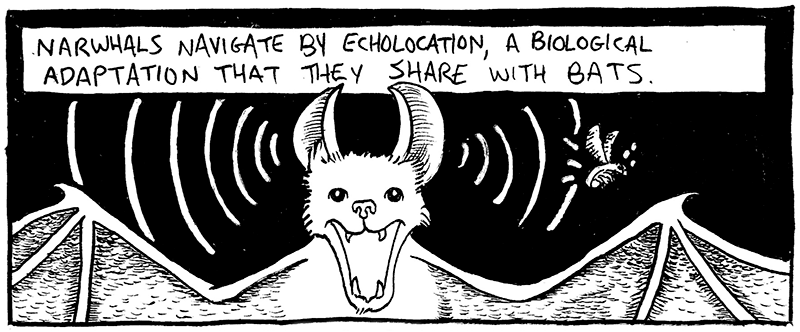
Yes, narwhal research projects are often conducted in collaboration with local native communities. Hunters are employed on all projects as assistants and are frequently the most important part of a successful field project. Hunters have participated on aerial surveys, expeditions to capture and tag narwhals, sampling harvested narwhals, and on trips out to the pack ice in helicopters. They also sometimes come to scientific management meetings. In all field projects, hunters have contributed their knowledge, skill, and experience, critical to the success of the research.
A dive to 1,500 m is about twice the height of the world’s tallest building.
Narwhals are very important to native communities. They have been harvested for subsistence for thousands of years by people in Arctic villages in both Canada and Greenland. These people rely heavily on the narwhal for food. In Greenland, most of the narwhal is eaten, including the meat, the blubber, the skin and the organs. Sometimes carvings or art pieces are made out of the bones or the tusk. The narwhal hunt is an important part of cultural identity and communities look forward to the arrival of the narwhal hunting season all year. Finally, the narwhal hunt in North Greenland is one of the last places where traditional kayak and harpoon hunting methods are used.
Narwhals live in an Arctic environment that is rapidly changing. In order to understand how they interact with their environment and how their population sizes, movements, distribution, or behavior will adapt to the changes currently happening (and predicted) in the Arctic, it is vital to develop a baseline, or basic understanding of their ecology. Furthermore, narwhals are an important cultural and material resource for native communities in Greenland and Canada. As resource managers, we must understand the structure and dynamics of the narwhal populations in a changing climate so that we can ensure they remain sustainable resources.
In addition to making deep dives, narwhals spend a large amount of their time below 800 meters. They can spend more than 3 hours per day there.
Climate change is the primary threat to narwhals. This includes loss of sea ice habitat and changes in the distribution of their prey, the Greenland halibut, with warming ocean temperatures. This might also be coupled with more sub-Arctic whales moving into the Arctic earlier in the season and for longer periods. This would increase competition for food and, perhaps, the frequency of predation by killer whales. Increasing human effects (referred to as “anthropogenic impacts”) in the Arctic are also big threats to narwhals. These include increases in shipping activity. With less sea ice and more open water for longer periods, cargo ships can travel new routes, such as the North West Passage. There has been an increasing number of tourist/cruise ships in narwhal habitat in the summer. Another potential threat is exploration and drilling for oil resources. If populations are not managed sustainably, overharvest may pose some threat as well.
It is well documented from ice core samples that the climate around Greenland, and thus narwhal habitat, has changed rapidly and drastically many times over the last hundred thousand years. Narwhals evolved as a species sometime during the late Pleistocene (500,000 thousand years ago), a period when temperature and climate changed dramatically. The Pleistocene is also the period where mammoths, mastodons, saber-tooth cats, and many other large mammals and birds evolved and went extinct. Narwhals have survived periods of high environmental variability and glaciations that covered its whole geographic range with ice. Therefore it is expected that the narwhal has some degree of flexibility in surviving climate change. However, the narwhal is truly an “arctic specialist”. It requires very specific habitats in both summer and winter, has specific migratory corridors, feeds on only a few prey species, and has a relatively small global population size and a low reproductive rate. It is unknown how narwhals will fare with the unidirectional and human-induced climate warming; however, most likely the immediate consequences will be negative for the species. Changes in the amount of sea ice are expected to have an impact on what habitats are used by narwhals, especially their important wintering grounds. Changes in sea temperatures, currents and ocean circulation will likely indirectly impact the biomass and distribution of their primary prey, the Greenland halibut.
The pressure at depths >800 meters can exceed 2200 PSI (150 atmospheres), which is kind of like giving a piggy back ride to twenty-two of your 100-pound friends, at the same time.
References for most of the information above can be found either in the peer-reviewed publications posted below, or in the literature cited within these articles.
Illustrations from Myths of the Tusk, an educational graphic novel by
Owen Curtsinger and Kristin Laidre.
